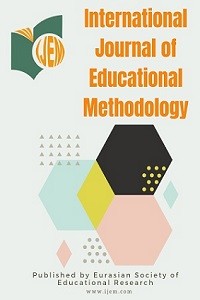The Influence of Active Learning on the Concept of Mastery of Sains Learning by Fifth Grade Students at Primary School
Öz
The research aims to know the effect of Active Learning on the concept of mastery of sains learning by fifth grade students at primary school. The method that is used in this research is a quasi-experimental research. The aspect being measured in this research was comparing two learning groups. Experiment group was exposed to Active Learning Model and control group to conventional learning model. The data population of this research was all fifth grade students (28 students) at Primary School Soropaten 2 district Klaten in academic year of 2017/2018. The population was then divided into two classes. 14 students were in the experiment class, and 14 students were in the control class. The data sampling of research conducted with cluster random sampling. Data collection techniques included tests and observations. Data analysis was done by using a t-test and descriptive statistics. The results showed that learning with Active Learning Model influences the concept mastery of sains learning. The result learning by fifth-grade students Primary School showed 2.990 with the significance level at less than 0.05 i.e., 0.006.
Anahtar Kelimeler
Active Learning fifth grade at primary school sains learning
Kaynakça
- Aklinoglu, O., & Tandogan, R. O. (2007). The effects of problem-based active learning in science education on students’ academic achievement, attitude and concept learning. Eurasia Journal of Mathematics, Science & Technology Education, 3(1), 71-81.
- Budiyono. (2016). Statistika untuk Penelitian. Surakarta: UNS Press.
- Cattaneo, K. H. (2017). Telling active learning pedagogies apart: from theory to practice. Journal of New Approach in Educational Research, 6(2), 144-152.
- Comacho, D. J., & Legare, J. M. (2015). Opportunities to create active learning techniques in the classroom. Journal of Instructional Research, 4, 38-45.
- Daouk, Z., Bahous, R., & Bacha, N. N. (2016). Perceptions on the effectiveness of active learning strategies. Journal of Applied Research in Higher Education, 8(3), 360-375.
- Daryanto. (2014). Pembelajaran Tematik Terpadu Terintegrasi (Kurikulum 2013). Yogyakarta: Gava Media.
- Mowsesian, R. (2010). The Elementary School (Principles and Problem). USA: Houghton Mifflin Harcourt.
- Nelson, L. P., & Crow, M. L. (2014). Do active-learning strategies improve students’ critical thinking? Higher Education Studies, 4(2), 77-90.
- Patton, C. M. (2015). Employing active learning strategies to become the facilitator, not the authoritarian: A literature review. Journal of Instructional Research, 4, 134-140.
- Prince, M. (2004). Does active learning work? a review of the research. Journal of Engineering Education, 93(3), 223-231.
- Samatowa, U. (2011). Pembelajaran IPA di Sekolah Dasar. Jakarta: PT Indeks.
- Setyosari, P. (2010). Metode Penelitian dan Pengembangan. Jakarta: Prenada Media Group.
- Silberman, M. L. (2009). Active learning: 101 strategi pembelajaran aktif. Yogyakarta: Pustaka Isnan Madani.
- Sugiyono. (2016). Metode penelitian kuantitatif, kualitatif dan R&D. Bandung: Alfabeta.
- Sukmadinata, N. S. (2014). Metode penelitian pendidikan. Bandung: Remaja Rosdakarya.
- Trianto. (2014). Model pembelajaran terpadu. Jakarta: Bumi Aksara.
- Warsono, & Hariyanto. (2013). Pembelajaran aktif. Bandung: Remaja Rosdakarya.
- Wilke, R. R. (2003). The effect of active learning on student characteristics in a human physiology course for nonmajors. Advances in Physiology Education, 27(4), 207-223.
- Wuryani, M. T., Roemintoyo, & Yamtinah, S. (2018). Textbooks thematic based character education on thematic learning primary school: An influence. International Journal of Educational Methodology, 4(2), 75-81. doi: 10.12973/ijem.4.2.75
- Zaini, H., Munthe, B., & Aryani, S. A. (2008). Strategi pembelajaran aktif. Yogyakarta: UIN Sunan Kalijaga.
Öz
Kaynakça
- Aklinoglu, O., & Tandogan, R. O. (2007). The effects of problem-based active learning in science education on students’ academic achievement, attitude and concept learning. Eurasia Journal of Mathematics, Science & Technology Education, 3(1), 71-81.
- Budiyono. (2016). Statistika untuk Penelitian. Surakarta: UNS Press.
- Cattaneo, K. H. (2017). Telling active learning pedagogies apart: from theory to practice. Journal of New Approach in Educational Research, 6(2), 144-152.
- Comacho, D. J., & Legare, J. M. (2015). Opportunities to create active learning techniques in the classroom. Journal of Instructional Research, 4, 38-45.
- Daouk, Z., Bahous, R., & Bacha, N. N. (2016). Perceptions on the effectiveness of active learning strategies. Journal of Applied Research in Higher Education, 8(3), 360-375.
- Daryanto. (2014). Pembelajaran Tematik Terpadu Terintegrasi (Kurikulum 2013). Yogyakarta: Gava Media.
- Mowsesian, R. (2010). The Elementary School (Principles and Problem). USA: Houghton Mifflin Harcourt.
- Nelson, L. P., & Crow, M. L. (2014). Do active-learning strategies improve students’ critical thinking? Higher Education Studies, 4(2), 77-90.
- Patton, C. M. (2015). Employing active learning strategies to become the facilitator, not the authoritarian: A literature review. Journal of Instructional Research, 4, 134-140.
- Prince, M. (2004). Does active learning work? a review of the research. Journal of Engineering Education, 93(3), 223-231.
- Samatowa, U. (2011). Pembelajaran IPA di Sekolah Dasar. Jakarta: PT Indeks.
- Setyosari, P. (2010). Metode Penelitian dan Pengembangan. Jakarta: Prenada Media Group.
- Silberman, M. L. (2009). Active learning: 101 strategi pembelajaran aktif. Yogyakarta: Pustaka Isnan Madani.
- Sugiyono. (2016). Metode penelitian kuantitatif, kualitatif dan R&D. Bandung: Alfabeta.
- Sukmadinata, N. S. (2014). Metode penelitian pendidikan. Bandung: Remaja Rosdakarya.
- Trianto. (2014). Model pembelajaran terpadu. Jakarta: Bumi Aksara.
- Warsono, & Hariyanto. (2013). Pembelajaran aktif. Bandung: Remaja Rosdakarya.
- Wilke, R. R. (2003). The effect of active learning on student characteristics in a human physiology course for nonmajors. Advances in Physiology Education, 27(4), 207-223.
- Wuryani, M. T., Roemintoyo, & Yamtinah, S. (2018). Textbooks thematic based character education on thematic learning primary school: An influence. International Journal of Educational Methodology, 4(2), 75-81. doi: 10.12973/ijem.4.2.75
- Zaini, H., Munthe, B., & Aryani, S. A. (2008). Strategi pembelajaran aktif. Yogyakarta: UIN Sunan Kalijaga.
Ayrıntılar
| Birincil Dil | İngilizce |
|---|---|
| Konular | Eğitim Üzerine Çalışmalar |
| Bölüm | Araştırma Makalesi |
| Yazarlar | |
| Yayımlanma Tarihi | 15 Şubat 2019 |
| Yayımlandığı Sayı | Yıl 2019 Cilt: 5 Sayı: 1 |


